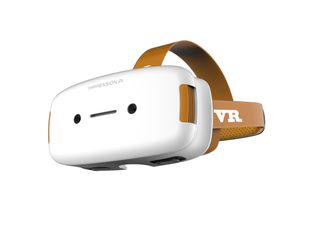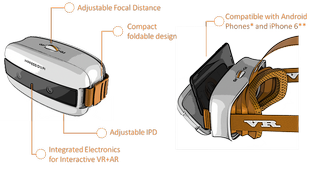Too Good To Be True? Impression Pi Joins The VR Game With Wireless HMD

The VR landscape continues to grow as more and more companies are coming out with a variety of VR products such as apps, sensors and head-mounted displays (HMDs). Impression Pi is one of those companies, and it claims its HMDs can deliver a number of features that could rival big companies such as Oculus and HTC.
Measuring 95 x 175 x 90 mm, the Impression Pi relies on a small motherboard, called the Core, that resides behind the faceplate. In addition to two lenses, the device also features an integrated CPU/GPU, an IMU sensor, and an IR tracker. This combination supposedly gives the HMD the unique abilities to display both VR and AR and employ gesture controls and wireless positional tracking.
Leap Motion is on a similar path, putting all of its efforts into implementing its hand-tracking sensors on the most popular HMD models. Last week, it announced a partnership with Razer to put the Leap Motion sensor on the faceplate as well as a separate peripheral on Razer's OSVR HMD.
The combination of virtual and augmented realities is interesting, but the company has yet to reveal the details of how it actually works. All we know is that it's the result of the HMD's dual lenses and an algorithm in the software code. The combination captures real world images and combines it with virtual objects, but it also keeps track of the space around the user, as well as their hand placements, to make the experience as realistic as possible.

The ability to wirelessly track your position is a big deal, as the VR demos I've experienced all had a certain limitation either due to the length of the wire or because the tracking sensor only had so much space to cover. The only company we're aware of that comes close to wireless positional tracking is Sulon, with its Cortex HMD, but even that is still early in the development phase. Nevertheless, the Impression Pi aims to be a completely wireless HMD.
A version of the Impression Pi can even be fitted with a compatible smartphone, just like Samsung's Gear VR. But that comes with limitations. First, you're restricted to the visual quality from the smartphone, and second, only VR apps developed with the Google Cardboard SDK or the Unity mobile engine can be used with the Impression Pi.
If you buy the high-end model (the "Master" package) of the Impression Pi, you don't have to use your smartphone because the company will install an Android board with its own display. This is a strange combination in that the Core board will handle tracking and the VR and AR data while the Android board is primarily used to power the display.
Stay on the Cutting Edge
Join the experts who read Tom's Hardware for the inside track on enthusiast PC tech news — and have for over 25 years. We'll send breaking news and in-depth reviews of CPUs, GPUs, AI, maker hardware and more straight to your inbox.
An interesting angle on the Impression Pi is the fact that it seems to be targeted more for everyday use. Your instincts might say that VR is more suited for games, but the device has additional purposes such as watching movies or sharing photos and videos, and even answering phone calls. The company went one step further and created its own UI to easily access media files on the Impression Pi.
Most of the features have yet to be tested, because just like all the other HMD makers on the market, the Impression Pi is still in development. The company just started a Kickstarter campaign this month for a goal of $78,000. The goal has been easily surpassed, with its current funding at over $144,000.

Backers have four different models to choose from. The basic package is called the Starter, and it only features the HMD without the Core board. Customers can use their compatible smartphones as the main hardware. (Think Google Cardboard, but a bigger HMD.) The Early Bird package on the crowdfunding page will cost $59, and the standard Starter package will cost $79.
The list of supported phones is below, and the company plans to support more soon.
- Motorola Moto X (2014)
- Google Nexus 5
- Google Nexus 6
- Samsung Galaxy Note 4
- Apple iPhone 6
- Apple iPhone 6 Plus
- HTC Desire Eye
- HTC One 2
- Sony Xperia Z3
- Xiaomi M4
- LG G3
- OnePlus One
The second package just includes the Core board. This is meant for enthusiasts who want to tinker with the hardware and see if they can implement it on their own custom HMDs. The idea sounds a lot like Razer's OSVR, with the big exception of cost. OSVR's HDK (which includes all of the hardware and software you need) is $200, while the Core board will cost backers $200 by itself.
The Empower bundle is a combination of the two lower packages. You get the Core board as well as the Impression Pi, which will still use your smartphone as the display, with a USB or Lightning connection inside the HMD. However, you can use the Core board to detect hand gestures, perform positional tracking, and implement augmented reality. The Early Bird package will cost $250, and the standard Empower package costs $279. For $314, you can purchase the Impression Pi Developer's Edition, which includes the Empower bundle, the full SDK, and technical support from the company. The package also allows developers to submit content to the Pi Store.
The high-end package is called the Master and will cost a hefty $359. This includes the HMD, the Core board, and a dedicated display for virtual reality. Instead of using your smartphone, the display will be embedded in the HMD, which is powered by the previous-mentioned Android board. In addition to having its own CPU, GPU, and RAM, the board also supports Wi-Fi at 2.4 GHz and 5 GHz.
The campaign won't end until May 7, so there's still time to invest in the Impression Pi. Right now, the company said the hand tracking is ready to go, but there are still improvements to be made on the head tracking -- specifically with latency and accuracy. The company's timeline showed that it will finalize the designs for the hardware in May and then test the hardware and software until August. The Starter models are due to come out in October, with the Empower and Master bundles following suit in early 2016.
There could still be changes in the hardware and software along the way, so it's unclear if the company is sticking to the schedule. Still, it's an ambitious play, and we'll be keeping an eye on it to see if it sticks to its claims and outperforms the other VR giants in the industry.
Follow Rexly Peñaflorida II @Heirdeux. Follow us @tomshardware, on Facebook and on Google+.
-
kijutsu Who ever can get their HMD out first with a few great games will get my money. For now I'll just keep my money and wait and see.Reply -
Quixit Seems like another opportunity to throw your money away. Everyone and their mother seems to be jumping into the VR headset game with a me too device. The chances of buying a device that's actually got content at the end right now is pretty low even if you buy one of the big names. Putting money down on a Kickstarter is like throwing your money away.Reply
Most Popular


